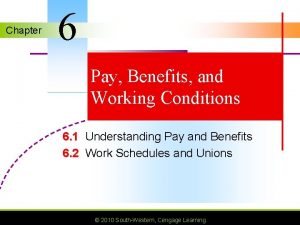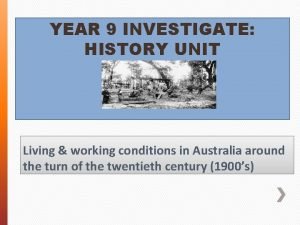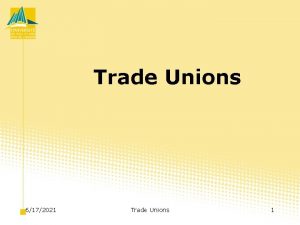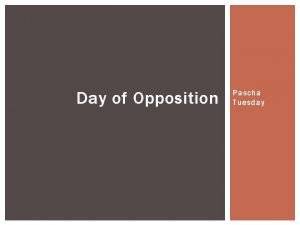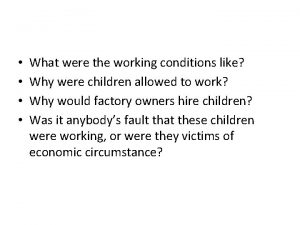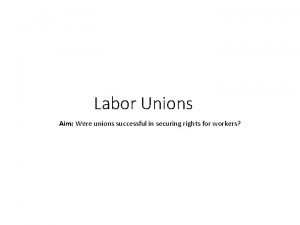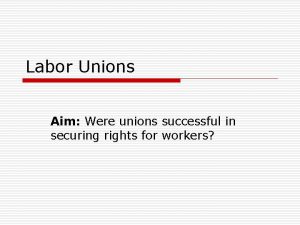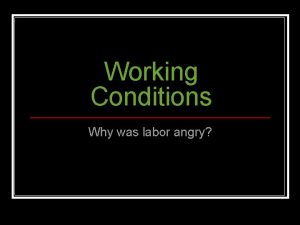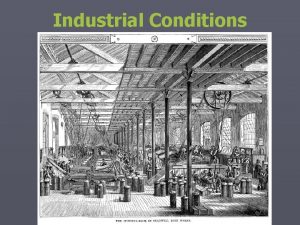Unions Working Conditions Opposition to Unions There were















- Slides: 15

Unions & Working Conditions

Opposition to Unions There were no laws giving workers the right to organize or requiring owners to negotiate with them, leaving workers who wanted to organize a union with major problems. Courts often ruled strikes as a conspiracy and labor leaders might be fined or jailed.

Opposition to Unions were also seen as a threat to American institutions. Ideas from Karl Marx, called Marxism, became very influential in Europe. Marx believed that the basic force shaping capitalist society was the class struggle between workers and owners. Workers would eventually revolt, seize control of the factories, and overthrow the government.

Opposition to Unions Marxist ideas came to America when thousands of European immigrants came to the U. S. Since many Americans were already anti-immigrant, they became very suspicious of unions This often led officials to us the courts, police, and army to crush strikes and break up unions.

The Struggle to Organize In the 1830 s, trade unions were formed to people with specific skills. Employers were forced to negotiate with trade unions because they needed those people’s skills. Industrial unions: united all craft workers and common laborers in a particular industry Opposed by owners of large companies Industrial unions rarely succeeded

The Struggle to Organize Techniques used by companies to prevent unions forming: Required workers to take oaths or sign contracts promising not to join a union Hired detectives to identify union organizations Workers who tried to organize a union were fired and placed on a blacklist If blacklisted, laborers could only get a job by changing residence, trade, or his/her name

The Struggle to Organize Union workers were also placed on a lockout Locked out of the property and refused their pay If a strike was called, employees would be replaced by strikebreakers (or scabs) Confrontation with owners and the government often led to violence and bloodshed The riot at Haymarket Square in Chicago led to the discrediting of the Knights of Labor (1 st nationwide industrial union) The Great Railroad Strike of 1877 and the Pullman Strike of 1894 both involved rail workers responding to wage cuts The army was sent to restore order

The American Federation of Labor Trade unions flourished in the late 1800 s. In 1886 the American Federation of Labor (AFL) was formed by delegates form over 20 of the nation’s trade unions. Samuel Gompers was the first leader of the AFL. His simple approach helped unions become accepted in American society.

American Federation of Labor Gompers preferred to negotiate before starting a strike. His three main goals for the AFL were: Convince companies to recognize unions and to agree to collective bargaining Push for closed shops, or companies that only hired union members Promote the 8 -hour workday.

American Federation of Labor The AFL had 500, 000 members by 1900 and was the biggest union in the country. AFL represented less than 15% of all non-farm workers A vast majority of workers remained unorganized and unions were still weak

Working Women made up more than 18% of the labor force by 1900. 1/3 rd worked as domestic servants 1/3 rd worked as teachers, nurses, sales clerks, and secretaries 1/3 rd employed in light industrial work Many more worked in the garment industry and food processing plants

Working Women were paid less than men, even if their performance was equal Many unions (including AFL) excluded women because it was believed that all women had a man supporting her and that the men needed the higher wages In 1903, Mary Kenney O’Sullivan and Leonora O’Reilly established the Women’s Trade Union League (WTUL) This became the first national trade association to promote women’s labor issues WTUL pushed for the 8 -hour workday, the creation of a minimum wage, an end to evening work, and the abolition of child labor

Working in the U. S. Industrialization brought about a dramatic rise in the standard of living for Americans. Real wages by the average worker rose about 50% between 1860 -1890. However, the division of workers between wealthy and working class caused resentment.

Working in the U. S. Life for workers in industrial America was difficult. Work was monotonous and repetitive Working conditions were unhealthy and dangerous Workers breathed in toxic fumes and heavy machines without safety devices caused many injuries.

References Appleby, J. , Brinkley, A. , Broussard, A. S. , Mc. Pherson, J. M. , Ritchie, P. A. (2006) The American vision (pp. 243 -251). New York, NY: Mc. Graw-Hill. Haymarket Flier retrieved from http: //en. wikipedia. org/wiki/File: Haymarket_Flier. jpg AFL logo retrieved from http: //en. wikipedia. org/wiki/File: AFLlabel. jpg Girl worker at the Denomah Mills retrieved from http: //www. loc. gov/pictures/resource/fsa. 8 c 03999/ Assembly line photo retrieved from http: //www. loc. gov/pictures/resource/det. 4 a 27966/
 There was there were ile ilgili cümleler
There was there were ile ilgili cümleler Chapter 6 pay benefits and working conditions
Chapter 6 pay benefits and working conditions Living and working conditions in australia 1900
Living and working conditions in australia 1900 European working conditions survey
European working conditions survey What is the job description of a computer programmer
What is the job description of a computer programmer Fair working conditions
Fair working conditions Working conditions meaning
Working conditions meaning European working conditions survey
European working conditions survey Capitalism def
Capitalism def Hot working and cold working difference
Hot working and cold working difference Machining operations
Machining operations Hard work vs smart work
Hard work vs smart work Proses pengerjaan panas
Proses pengerjaan panas Advantages of hot working over cold working
Advantages of hot working over cold working Identifying dependent and independent variables
Identifying dependent and independent variables Dependent variable vs independent variable
Dependent variable vs independent variable

